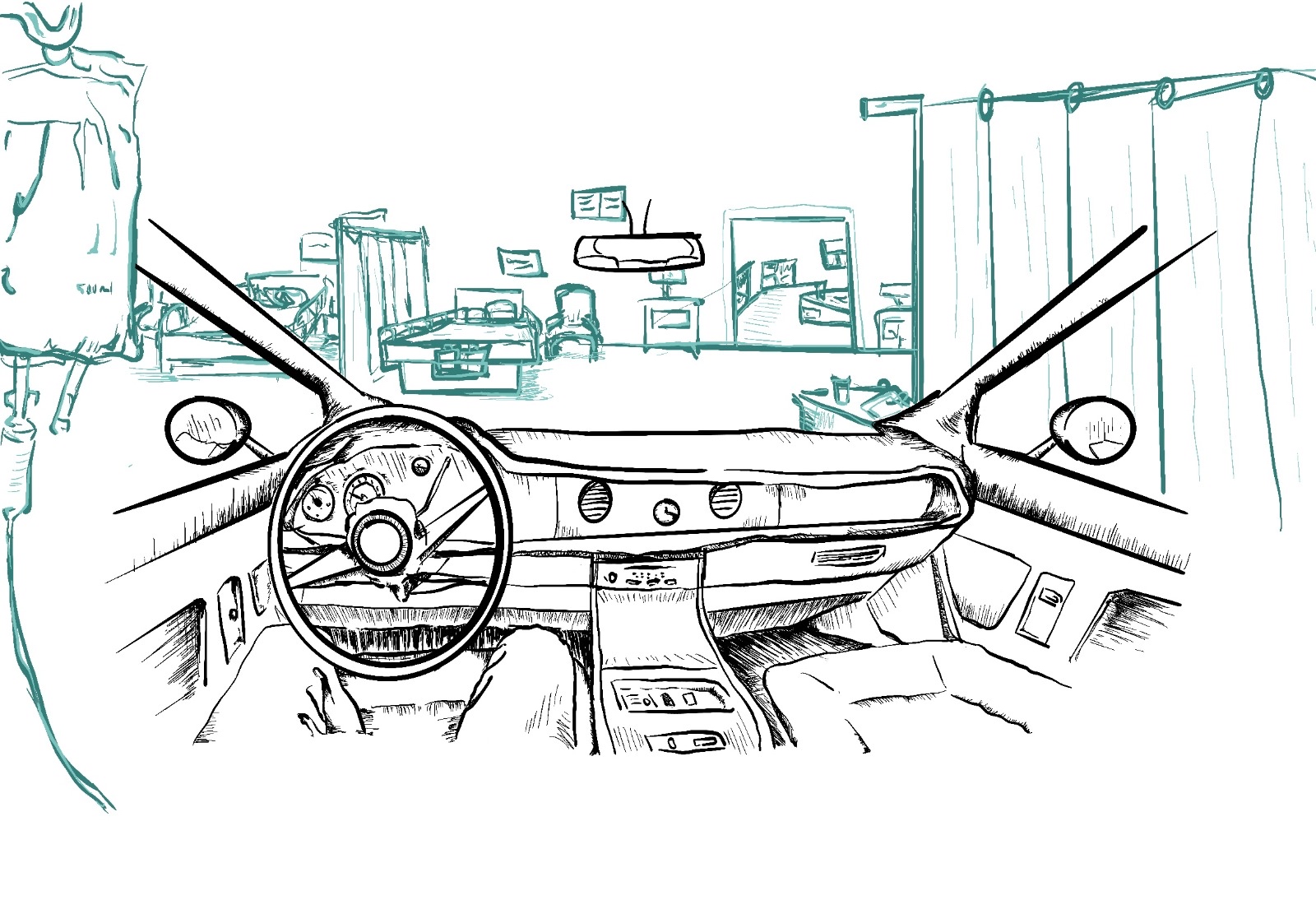Behind the Wheel
In this simple digital line drawing, I explore the idea of taking the patient’s perspective, with or without capacity, when caring for them. The viewer is invited to take the position of the driver of a Rolls-Royce. Effectively, we are the patient, but in the position he views himself: young, active and working for one of the most popular vehicle manufacturing companies in his time. In contrast with the foreground, the background is depicted in real time on the ward – the true setting the patient and I were in. Through the medium of a drawing, I can depict a surreal setting which suggests that both the patient’s understanding of reality and my own perception of reality can somehow coexist. This mutual understanding allows me to support him and maintain patient safety, and importantly, respect his right to feeling safe and rationalise the world around him – allowing him to have control of his own wheel.
Having family members with dementia, I have dealt with similar situations in the past – yet this experience has taught me that when caring for patients with any form of dementia, not one size fits all. Creating this piece has shown me that some essential patient information cannot be found readily in their medical notes, and that considering the perspective the patient themselves provide – whether it is fact or not – is equally as crucial.
I enjoyed the process of creating this piece as I feel that I have reflected on my own approach to caring for older patients – understanding that although that there are some procedural steps to patient interactions, I will require an element of creativity, open-mindedness and self-awareness to supplement this and better attend to a patient’s holistic needs. Furthermore, creating this piece has made me want to further explore other ways in which whole-person care presents in a clinical setting, and what my role is in ensuring its fruition.
Annual Creative Prizewinner
Comments
Add legacy comments here

I really like this piece of artwork and I think the contrast between the patients current and past experience is really poignant and effective and gives a key insight into what it is like to work with patients with dementia. It gives a very powerful visual representation of both the artists and patients experience and how they managed to overcome any barriers in working with this patient by listening and understanding which allowed them to perform their tasks more effectively. Their reflection shows the importance of patient centred care and treating every patient as an individual which will be very helpful to take forward into placements in future.
I believe that this piece of art perfectly captures the essence of what it means to be empathetic as a health-care worker in a clinical setting. It encourages one to put an effort into seeing the world from a patient’s perspective regardless of their medical capacity which might be a crucial step in providing them with holistic care. It shows the importance of inculcating creativity, empathy and open mindedness into one’s clinical practice and illustrates perfectly not only how it can make one better at their job but also how it can positively impact the patient.
This artwork provides an interesting perspective on the contrast of what the patient may be perceiving as opposed to the doctor. The fusion of both worlds gives an insight into how both parties must collaborate and find an even ground to gain an understanding of each other. The accompanying story is useful to understand how listening can grant access to a whole new view which may not have been seen before, as depicted in the artwork through the view of the car. My favourite aspect of this is the choice for a first-person view, as it feels personal to this individual patient and provides their unique viewpoint to the world, displaying how each patient has their own individual views and perspectives.
This insightful piece explores the complexities of caring for patients with dementia, underlining the significance of understanding and embracing their unique perspectives. Using a digital drawing, it vividly portrays the coexistence of the patient’s idealized world and the hospital reality, emphasizing the need for flexible, individualized care. The artist’s personal experience with dementia adds authenticity, encouraging healthcare providers to approach patient care with creativity and open-mindedness. Ultimately, it prompts reflection on the importance of recognizing diverse realities in healthcare settings.